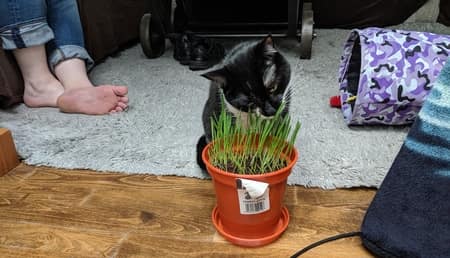
Cat grass in a normal kit lasts about two weeks, as they use shallow bowls that quickly fill with the grass’s roots.
In a deep pot with lots of space for the roots, cat grass can live for a few months.
Cat grass seed types are annual and not perennial, which limits how long they can live for.
Many cats (especially indoor cats) enjoy having a bowl or tray of cat grass to munch upon. There is no doubt that the roughage and vitamins your cat gets from grass helps maintain their health.
But the main question I get regularly asked is … how long does cat grass last?
The simple answer is that the life of the cat grass depends a lot on the environment into which it is planted, as noted below.
- The depth of the pot
- The quality of the soil
- The number of hours per day that the plant receives direct sunlight
- Careful watering to prevent saturation
- Trimming and maintaining the plant.
All these factors contribute to the life of the grass. If you give the cat grass the right conditions, you can extend its life for several months.
Give the plant a deep wide pot, where the roots can roam and find plenty of nutrients, and it will last for months. If you plant out a small shallow container, the grass will not last longer than three weeks at the most before its roots starve to death as they compete for space.
Therein lies the secret to a long and lasting life for your plant. Allow it to grow and expand without getting root bound too soon, and it will reward you with a long life, which means you will require a deeper container than you would normally think you would need.
Archie is eating from grass that is 2 months old, it has lived that long because the pot is nice and deep.

Feed and Nurture Your Cat Grass to Make it Last.
After providing the plant with the room it needs to live longer and stronger (a larger pot), your plant will require essential plant elements to survive and thrive. Like a well-manicured lawn, your cat grass requires the same three essential elements that most plants and grasses need to thrive.
They need.
- Sunlight – your cat grass will require a sunny spot to bask in the warm sunshine, which encourages it to grow.
- Water – keeping your grass moist but not soggy promotes the life of your plant.
- Nutrients – from the soil and the sun that enriches the growing stages of the grass providing strong and flavoursome grass.
If you can provide your grass bowl with these three life essentials, your cat grass will flourish. Why is this important? Because if it is given everything it requires, you will be rewarded by long-lasting cat grass.
Instead of struggling to survive for 1-2 weeks, when you provide the above requirements, your cat grass will last from five weeks to several months if you pamper your grass.
If your plant has all these requirements, the grass will be pliant and tasty, rather than harsh and tasteless. It will last a lot longer than a neglected bowl of grass.
As a cat owner, you know which one of these options will appeal most to your connoisseur cat!
Understand Annual and Perennial Plants and Their Lasting Capabilities.

There are two types of plants, Annuals, and Perennials.
- Perennials are blessed to live longer than a season and can become permanent residents. In other words, they rarely need replanting, and as the seasons pass, they grow denser and stronger.
- The other variety of plants are classified as annuals, which means they only last a growing season before they fade away and die.
Your cat grass is in this category, they are short living annuals. Plants in this category have rapid growth and then fizzle and die. Your cat grass will always require being replanted at the end of each growth cycle. They will never live forever, but with the right care, you can prolong the life of the plant, so it lasts the full length of the cycle.
The Sneaky Way to Have ‘Ever Lasting’ Cat Grass

Having to replant your cat grass is not a bad thing as it means you can produce quality young grass. You can stagger the growth of your cat grass – begin with one pot, and then when that is established, start another pot. When the first bowl of the cat grass starts to die off, you can replace it with the second pot that you have.
This is the ideal solution to having cat grass readily available for your cat. Having two or three pots of the grass means you will never run out of a full bowl of greens for your kitty. You can grow grass seed in any season if you control the temperature inside your home. Also try to move the plant around the inside of your home to catch the most of the sun’s rays during the seasons.
Having two or more pots of cat grass growing at different stages of the growth cycle is as close to having everlasting cat grass all year round that you will ever get!
What is Cat Grass and Why Doesn’t It Last as Long as My Lawn?
Cat grass is not like the grass that you lovingly care for on your front lawn.
- Your lawn grass is usually a much tougher, hardwearing type of plant that can tolerate a wide range of climatic and weather variations. It is also a perennial which grows for many seasons.
There are a variety of types of lawn grass (for example, Kentucky Bluegrass which prefers colder climates or Bermuda Grass that loves heat and sunlight), but most are blessed to live long and last well. The grass has ample space in the ground for their roots to grow and spread, as the plant seeks moisture and nutrients from the earth.
- Cat grass, on the other hand, is grown to give your cat nutrition or provide roughage in their diet.
It is an annual type of plant, meaning that it will live for only one season. The cat grass is usually either barley, wheat, oats, rye, or a mix of the different types.
The beauty of growing cat grass at home is that they are without pesticides, which are toxic to pets, and they are young fresh plants that are pleasant for your cat to eat. But they do not last for long due to the limited soil in their container and the fact that they are an annual plant.
If you have ‘green fingers’ and regularly care for your cat grass it will last longer than the ‘select, then forget’ type gardener of cat grass.
Understanding the History of Cat Grass

Did you know that grass is the common name for the Gramineae family of plants? This family is one of the largest on Earth, with over 9000 known species.
There is nothing difficult about grass; it has a very simple structure. Understanding this fact about grass will help you to grow the grass successfully and enable a longer life for the indoor plant.
- The life of the plant comes from the grassroots which extend down into the soil like tiny thread-like fingers, seeking water, collecting nutrients and they secure the plant to the soil
- This is important to the life of the plant as it has that stability to survive being grazed by your cat; meaning it’s not easy for your cat to pull the plants out!
- If you want your cat grass to last for a few weeks, you want to ensure that those grassroots find what they are looking for; the nutrients and moisture they require.
The Last Word.

While cat grass will not last forever, having a rotation of plants within the house will enable your cat to enjoy a year-round supply of grass. The minimum effort required to plant a bowl or two of cat grass is worth it. Imagine all the health benefits for your cat from those gorgeous green bowls of grass decorating your home!
Although the life cycle of cat grass is limited, with the right container and care, you can extend the life cycle by at least one or two months.
And the take-away point is this. Having several rotating bowls of grass available for your cat is the next best thing to having long-lasting cat grass!
Writer: Jean Brewer

Sources
https://home.howstuffworks.com/grass2.htm
https://archiecat.com/cat-grass-dying/
https://www.catsincare.com/cat-grass/
https://catspro.com/how-to-grow-cat-grass.html
https://www.petmd.com/cat/care/evr_ct_how-to-grow-cat-grass
https://www.adventurecats.org/indoor-adventures/best-indoor-grass-cats/
https://homeguides.sfgate.com/difference-between-annuals-perennials-46015.html
https://www.hunker.com/13404886/the-difference-between-annual-perennial-grass
https://homeguides.sfgate.com/how-to-grow-cat-grass-13427630.html